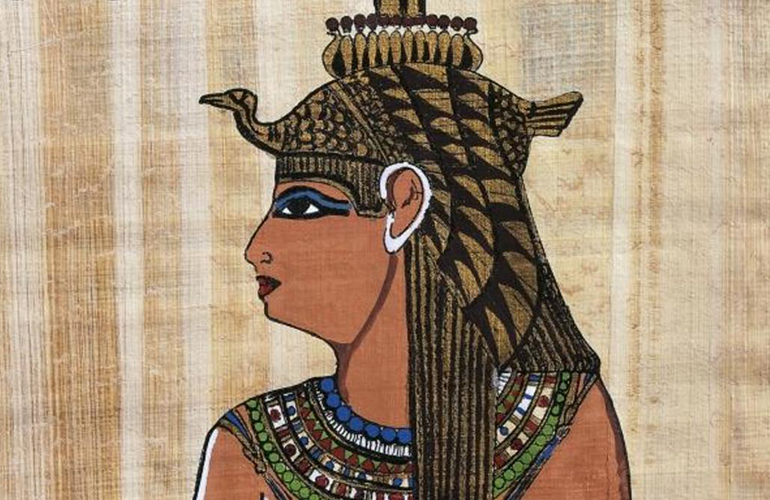All facts about queen Cleopatra
Cleopatra VII Philosopher (69 BC – 12 August 30 BC) was an Egyptian queen and the last pharaoh of ancient Egypt. She was a member of the Ptolemaic dynasty, a Greek-speaking dynasty that ruled Egypt in 300 BC. Deposited from power by her brother, She is aligned herself with Julius Caesar to regain the throne. After Caesar’s murder, she became Mark Antony’s lover. But after Mark Antony was defeated by Octavian’s forces during the Roman civil war, Antony and Cleopatra committed suicide, rather than fall into Octavian hands. His death marked the end of the Ptolemaic kingdom of Egypt – and Egypt was absorbed by the kingdom of the Ptolemaist.

Cleopatra marriage
Marriage between brother, sister and father-daughter was a long-standing practice in the Egyptian royal family. It was perhaps an emulation of gods like Osiris and Isis and the way of the pharaohs (who were considered as incarnations of the gods themselves) to imitate the gods and goddesses and to distinguish themselves from the rest of the population. Although hated by the Greeks, this practice was introduced to the Ptolemaic dynasty by Ptolemy II and his sister Arsinoe II, a few centuries before Cleopatra VII. Thus, after the death of his father in 51 BC, when she ascended the throne of Egypt with his younger brother Ptolemy XIII, the two may have married as was the custom at the time. The arrangement was not successful, as they both worked against each other, which led to the drowning of Ptolemy XIII as they fled across the Nile in the Battle of the Nile in 47 BC. The Roman general Julius Caesar was meanwhile in an affair with her and put her back on the throne, this time with another of his brothers, Ptolemy XIV who was 12 or 13 years old. The young Pharaoh and Cleopatra were married, but she continued to act as Julius Caesar’s lover, keeping for herself the present authority over Egypt
Ambitious Cleopatra
Cleopatra was an ambitious queen. She wanted to control her kingdom since her ascension as Queen of the Pharaoh in 51 BC. In 48 BC, She succeeded in charming the esteemed Roman general Caesar during her visit to Alexandria, thus exacerbating the rivalry between her and her brother Ptolemy XIII, her husband. The ensuing policy led to the siege of the Palace of Alexandria with Caesar and Cleopatra trapped together inside. Arsinoe IV, the younger sister of the two, had joined forces with her brother Ptolemy XIII against her sister Cleopatra in this fight. The siege ended in 47 BC after Caesar’s reinforcements arrived and he won the battle of the Nile. Ptolemy drowned in the Nile and Arsinoe was exiled to the Temple of Artemis in Ephesus. A few years later, in 41 BC, Arsinoe was executed on the steps of the same temple, on the orders of another lover of his sister, Mark Antony.
Cleopatra and Dictator
Ptolemy XIV was Cleopatra’s youngest brother who was appointed Pharaoh in 47 BC after the death of Ptolemy XIII. Although she was married to him, she continued to act as the lover of the Roman dictator Caesar. Perhaps it was Caesar’s assassination in 44 B.C. in Rome that precipitated the death of Ptolemy XIV. She probably poisoned him with aconite. Ptolemy XIV was replaced by Ptolemy XV Caesar, better known as Caesarion, who was her child with Caesar. Now that her infant child was co-regent, her position in Egypt was more secure than ever and she intended to support her child as her father’s successor
Cleopatra on her way to power in Egypt
In 48 BC, after the assassination of his political rival Pompey, Julius Caesar arrived in Alexandria hoping to repay the debts contracted by Cleopatra’s father, Auletes. Ptolemy XIII who had ordered the assassination of Pompey hoped to obtain Caesar’s favor, but Caesar was furious at the murder of a Roman consul by a foreigner. Cleopatra, on the other hand, needed Caesar’s support to regain full control of his brother’s Egypt. The historian Cassius Dio tells how she was, without informing his brother, charmed Caesar with his pretty dress and his spirit. Plutarch, on the other hand, provides a more captivating account, alleging that she smuggled into the palace to meet Caesar tied in a bed bag. In any case, she and Caesar were soon involved in a case that propelled her to power in Egypt and lasted until Caesar’s assassination in 44 BC. She gave birth a Son named Ptolemy XV Caesar in 47 BC, who would be the child of Julius Caesar.
Cleopatra is known to have joined Julius Caesar in Rome somewhere in 46 B.C., where she was housed in Caesar’s private villa beyond the Tiber. At that time, Caesar granted her and Ptolemy XIV the legal status of “friend and ally of the Roman people”, and it is possible that he also established the golden statue of Cleopatra in the Temple of Genetrix.
This Queen was in Rome when Caesar was assassinated in 44 B.C. She prolonged her stay in the vain hope that Caesar’s son, Caesar’s son of love, would be recognized as Caesar’s heir. The revelation of Caesar’s will and the declaration of his nephew’s grandson Octavian as his main heir left her depressed and she soon went to Egypt.
Cleopatra and Mark Antony
Cleopatra began her legendary love affair with the Roman general Marc Antony in 41 BC. Their relationship had a political component – she needed Antony to protect his crown and maintain Egypt’s independence, while Antony needed access to Egypt’s wealth and resources – but they were also very attached to each other. According to the ancient sources, they spent the winter of 41-40 BC living a life of leisure and excess in Egypt, and even formed their own drinking society known as the “Inimitable Liver”. The group was involved in night and wine festivals, and its members occasionally participated in elaborate games and contests. One of Antony and Cleopatra’s favorite activities would have been to wander the streets of Alexandria in disguise and play tricks on its inhabitants.
Cleopatra led a fleet in a naval battle.
She eventually married Mark Antony and had three children with him, but their relationship also caused a massive scandal in Rome. Antony’s rival, Octavian, used propaganda to portray him as a traitor under the influence of an intriguing seductress, and in 32 BC, the Roman Senate declared war on her. The conflict reached its peak the following year during a famous naval battle in Actium. Cleopatra personally led several dozen Egyptian warships into the melee alongside Antony’s fleet, but they were not up to Octavian’s fleet. The battle soon turned into a rout, and she and Antony were forced to break through the Roman line and flee to Egypt.
Cleopatra Defeat and Death
Cleopatra and Antony committed suicide in 30 BC after Octavian forces pursued them in Alexandria. While Antony is said to have stabbed himself to death in the stomach, Her method of suicide is less certain. Legend has it that she died seducing an “asp” – probably an Egyptian viper or cobra – to bite her arm, but the former columnist Plutarch admits that “what really happened is unknown to anyone”. He says she was also known to hide a deadly poison in one of her hair combs, and historian Strabo notes that she may have applied a fatal “ointment”. It is in this spirit that many researchers now suspect that she used a pin soaked in a form of powerful snake toxin venom or other.
Book your Travel Package now to know more about Egypt history






